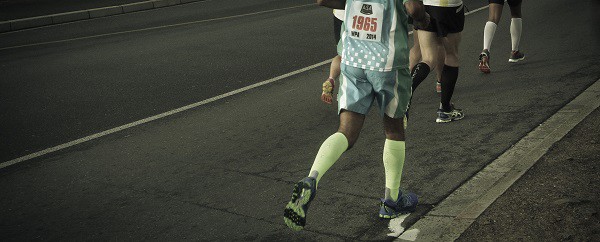If you’ve never used compression socks before and remain unconvinced about the benefits they could have for you, read on! – BY SEAN FALCONER
Not so very long ago, compression socks were unheard of in running circles, but when some elite athletes started running in them, notably women’s marathon world record holder Paula Radcliffe, the craze soon spread. More elites started wearing them, despite the fact that they looked a bit funny, and nowadays you’ll see them on the track, in road running, trail running and triathlons, and even back of the pack runners are wearing the skin-tight, knee-length socks during runs, while still more are wearing them after a run as well.
Some runners believe that compression socks actually make them faster, but there is little physical evidence to back that up, whereas a growing body of research confirms that compression wear offers real physiological benefits, both during and after a run. Just as a massage applies pressure to reduce inflammation and soreness in muscles, similarly, when compression gear is worn for a few hours after a workout, it has been shown to measurably reduce swelling and fatigue.
Compression socks work by promoting bloodflow from the lower extremities using gradiated compression – in other words, the sock is tightest around your ankle and the rate of compression slowly decreases further up your calf. This promotes bloodflow back up to the heart, where it is oxygenated and cleaned, and then it can flow back to the tired muscles and help them recover faster. Thus wearing the socks after a run promotes faster healing, but wearing them during a run speeds this process up even more, and the added bonus is that the socks reduce the amount of micro-damage to your muscles by decreasing the amount of shock and movement in the muscle every time your foot lands. In other words, your muscles can’t ‘jiggle’ as much, so they don’t suffer as much damage. For that reason, wearing compression tights on your quads is also highly recommended for runners, especially if you often suffer from stiff quads after a long run.
NOT SO NEW
The science behind compression wear has actually been around from the middle of the 20th century, when doctors and physicians started using compression garments to treat patients who were recovering from surgery, fractures, arthritis, varicose veins and other conditions or procedures. Then somebody smart asked if it would work for sportsmen and women, and in 1987 the American Journal Of Physical Medicine published a study by two doctors called Michael J Berry and Robert G McMurray, which revealed that athletes wearing compression stockings recovered a lot faster than athletes not wearing compression stockings.
So today an Olympic athlete in his or her prime and a pensioner who just had surgery on his or her varicose veins both wear compression stockings for the same reason, to get the blood pumping and to aid recovery. Granted, sport compression gear is not the same as the compression wear doctors recommend after surgery, because some of the latter is so tight that it requires a prescription, for safety purposes, but the principle is the same.
So if you have not tried compression socks yet, you may want to think again. After all, most of us know the traditional acronym RICE when it comes to treating an injury: Rest, Ice, Compression and Elevation. It’s been there all along, right in front of you, so go get the socks.


